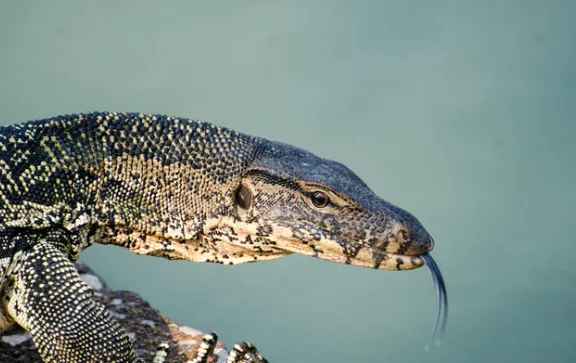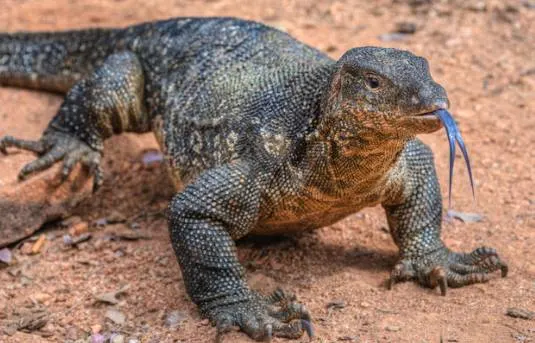The Asian water monitor (Varanus salvator) is a remarkable lizard native to South and Southeast Asia. Known for its impressive size and adaptability, it is the second heaviest lizard in the world, surpassed only by the Komodo dragon. This species is a marvel of nature, showcasing a blend of power, versatility, and survival prowess.

Table of Contents
Scientific Classification
- Kingdom: Animalia
- Phylum: Chordata
- Class: Reptilia
- Order: Squamata
- Family: Varanidae
- Genus: Varanus
- Scientific Name: Varanus salvator
Conservation Status
- IUCN Status: Least Concern
Habitat and Distribution
The Asian water monitor is widely distributed across tropical regions of South and Southeast Asia, including countries such as China, India, Indonesia, Vietnam, and Sri Lanka. They prefer habitats close to water sources, such as mangrove swamps, wetlands, and urban areas with canals. Their adaptability to diverse environments, including urban landscapes, underscores their ecological versatility.
Physical Characteristics
- Color: Typically black or dark brown with yellow markings
- Weight: 35 to 44 pounds
- Length: 4 to 9 feet
- Lifespan: 11 to 25 years in captivity
These lizards possess muscular bodies with long, laterally compressed tails that aid in swimming. Their black and yellow markings make them easily identifiable. Equipped with powerful jaws, sharp claws, and strong tails, they are formidable predators and efficient swimmers.
Behavior and Lifestyle
Asian water monitors are solitary and diurnal, being most active during the day. They are exceptional swimmers, using their tails as paddles. While generally docile, they can become aggressive if threatened. Their defense mechanisms include powerful bites, sharp claws, and strong tail lashes.
Diet
As opportunistic carnivores, their diet includes:
- Frogs
- Rodents
- Young crocodiles
- Fish
- Eggs
- Turtles
- Domesticated cats and dogs
- Human food waste
- Chickens
- Decaying flesh of animals and humans
Their ability to scavenge on a wide variety of
Reproduction
Asian water monitors are oviparous, laying between 10 and 40 eggs per clutch. The incubation period lasts six to seven months. Females typically lay eggs in tree stumps or rotting logs. Hatchlings are independent from birth, and it takes a couple of years for them to reach adulthood, with males growing significantly larger than females.
Predators and Threats
Primary predators of Asian water monitors include saltwater crocodiles and King cobras. Humans also pose significant threats through hunting for their skin and meat, as well as habitat destruction. Despite these threats, their wide distribution and adaptability help maintain stable populations.
Interesting Facts About the Asian Water Monitor
- Heaviest Lizard: The Asian water monitor is the second heaviest lizard globally, only surpassed by the Komodo dragon.
- Semiaquatic Lifestyle: These lizards excel in both aquatic and terrestrial environments due to their swimming and climbing abilities.
- Scavengers: They consume a variety of prey, including decaying flesh, aiding local authorities in locating missing persons.
- Venomous Bite: Although venomous, their venom is not lethal to humans.
- Size Record: The largest recorded specimen was 10.5 feet long.
- Lifespan: They can live up to 25 years in captivity.
- Cultural Importance: In certain regions, they are protected due to their role in controlling pest populations.

Evolution and Origins
The Asian water monitor originates from South and Southeast Asia, thriving in regions from Sri Lanka and India to Indochina, the Malay Peninsula, and various Indonesian islands. Their evolutionary adaptations, such as powerful swimming capabilities and versatile habitat preferences, make them resilient and widespread.
The Asian water monitor is an extraordinary example of nature’s adaptability and resilience. Its role in various ecosystems, ability to thrive in diverse environments, and fascinating physical and behavioral traits make it a subject of interest for both scientific study and conservation efforts. Despite facing significant threats, its wide distribution and ecological flexibility ensure its continued survival.
- Enchi Ball Python: A Unique and Stunning Morph of Python regius - March 27, 2025
- Emerald Tree Monitor: The Enigmatic Green Guardian of the Rainforest - March 26, 2025
- The Egyptian Cobra (Naja haje): A Fascinating Serpent - March 25, 2025
